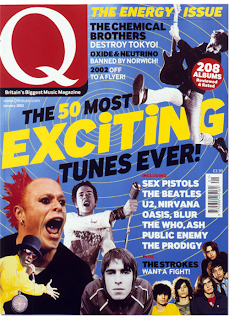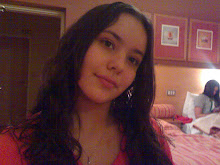My magazine challenges forms and conventions of real media products as it has a funkier, edgier appeal to it. There are not many magazines around with this image, as the audience (those who listen to dance music) is not one that is often targeted. This is partly due to the fact that the dance trend has only recently come back into fashion. Although it was around in the 1990’s, it seems that its audience had drifted from it and towards other genres, therefore so did the media. This is part of the reason why I chose such a demographic; because this genre has not been recently developed in the form of a magazine.
Most of the magazines of today follow one of two styles. Firstly, there are the very polished magazines with clean finishes that have been edited to create a perfect image, which usually have a well-presented and airbrushed artist or group on the cover. Secondly, there is also the more grainy-looking and edgier type of magazines, which often convey a more outgoing sense. Although this is partially due to the music genres being targeted, there are certain similarities within the groups. For example, NME and Metal Hammer attract two very different audiences, however when looking at certain issues, they both share the edgy essence that I speak of. My magazine does not fit into either of these groups as the colours suggest a clean and tidy appearance, however the common connotations labelled to this particular music genre may suggest otherwise.
Most of the magazines of today follow one of two styles. Firstly, there are the very polished magazines with clean finishes that have been edited to create a perfect image, which usually have a well-presented and airbrushed artist or group on the cover. Secondly, there is also the more grainy-looking and edgier type of magazines, which often convey a more outgoing sense. Although this is partially due to the music genres being targeted, there are certain similarities within the groups. For example, NME and Metal Hammer attract two very different audiences, however when looking at certain issues, they both share the edgy essence that I speak of. My magazine does not fit into either of these groups as the colours suggest a clean and tidy appearance, however the common connotations labelled to this particular music genre may suggest otherwise.
My media product represents the often-stereotyped youth of today and is offered from a local North London perspective. As stated in the ‘letter from the editor’ on the contents page, the makers of Massive are presented to be 14-19 year olds that all come from the London borough of Haringey. Again, referring to the contents page, there is a faded blue ‘boom box’ on the background of the page, which informs the audience that the magazine is all about music and also narrows it down to particular genres of music. This is due to the fact that a boom box has connotations that propose the idea of loud dance music and hip-hop. Of course my demographic includes those who listen to funky house music, a new style mixture of garage music and pop. This genre is implied by the use of colour and style.
I think that the kind of media institution that might distribute my media product is EMAP, a British media company, specialising in the production of business-to-business magazines. This is because they recently sold many parts of the company and are therefore more likely to be looking for new material to work with. I am also aware that EMAP are capable of distributing successful music magazines as they used to manage magazines like Smash Hits, which ran for over 25 years.
The audience for my media product are teenagers and those in their early twenties. At the very beginning of my project whilst doing my planning work, I had decided that the magazine was going to be aimed at 14-24 year olds. Throughout the course of the term I have developed my product to fit this specification. Thus, the target audience remains as this age group.
The ‘vibe’ given by the front cover is quite outgoing and original. The use of bright colours and the graffiti wall behind the featured group suggest this. The title also suggests that the magazine has been made to fit the needs of this age group as it is written in a very retro and bright typeface. The three girls (T-Starz) featured on the front cover of the magazine are wearing various vivid colours, which in itself attracts a viewer’s attention.
The contents page of my media product continues the idea of contrasting colours as it has a black background with bright blue, pink, yellow and green writing over it. Originally I was going to have a standard white background, but I soon discovered that the writing on the page somewhat blended in with this and therefore it wasn’t a successful choice. My article on the other hand has a slightly more relaxed feel to it as I have incorporated fewer colours and there is lots of empty space to keep the page looking clean and simple.
Throughout the course of this project I have been asked to use two types of software. The first is Blogger, an online blogging website to use as a commentary for my progress; and the second, is Adobe Photoshop, which I used to adapt and manipulate my images. When beginning the project I had recently begun using Photoshop at home. This gave me an advantage as I had already had some practice and time to warm to the technology. Now that I have operated them for a few months I can say that I enjoy using them both. I feel as though I have increasingly progressed with my knowledge of the technologies and do intend to continue using them both in the future.
When looking back at my preliminary task, I feel that I have learnt a lot in the progression from the beginning of the year to the full product. I have spent a lot of time working on the project and therefore have had more practice using the technology. I began my project by doing some magazine content research, which taught me a lot about the industry and what essential aspects every magazine must include. It has also become clear to me what is required specifically for a music magazine, as my student magazine consisted of very different properties.

















